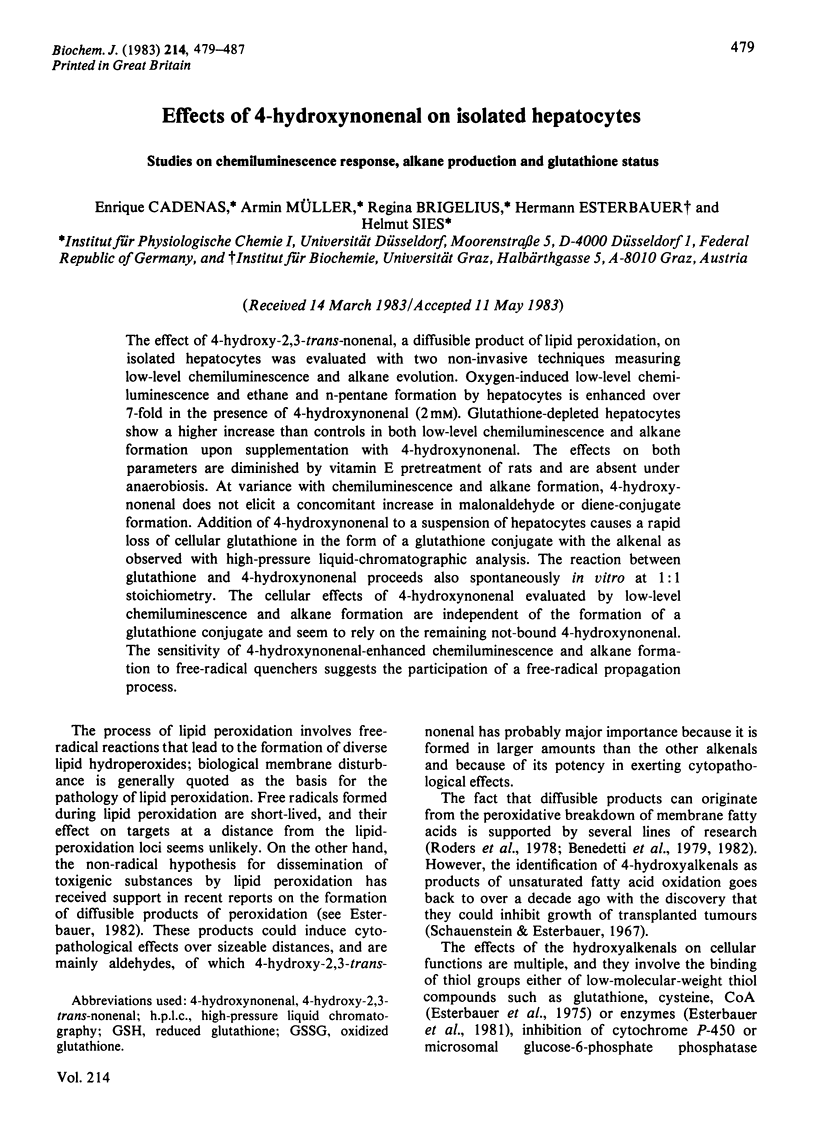Abstract
The effect of 4-hydroxy-2,3-trans-nonenal, a diffusible product of lipid peroxidation, on isolated hepatocytes was evaluated with two non-invasive techniques measuring low-level chemiluminescence and alkane evolution. Oxygen-induced low-level chemiluminescence and ethane and n-pentane formation by hepatocytes is enhanced over 7-fold in the presence of 4-hydroxynonenal (2 mM). Glutathione-depleted hepatocytes show a higher increase than controls in both low-level chemiluminescence and alkane formation upon supplementation with 4-hydroxynonenal. The effects on both parameters are diminished by vitamin E pretreatment of rats and are absent under anaerobiosis. At variance with chemiluminescence and alkane formation, 4-hydroxynonenal does not elicit a concomitant increase in malonaldehyde or diene-conjugate formation. Addition of 4-hydroxynonenal to a suspension of hepatocytes causes a rapid loss of cellular glutathione in the form of a glutathione conjugate with the alkenal as observed with high-pressure liquid-chromatographic analysis. The reaction between glutathione and 4-hydroxynonenal proceeds also spontaneously in vitro at 1:1 stoichiometry. The cellular effects of 4-hydroxynonenal evaluated by low-level chemiluminescence and alkane formation are independent of the formation of a glutathione conjugate and seem to rely on the remaining not-bound 4-hydroxynonenal. The sensitivity of 4-hydroxynonenal-enhanced chemiluminescence and alkane formation to free-radical quenchers suggests the participation of a free-radical propagation process.
Full text
PDF








Selected References
These references are in PubMed. This may not be the complete list of references from this article.
- Akerboom T. P., Bilzer M., Sies H. The relationship of biliary glutathione disulfide efflux and intracellular glutathione disulfide content in perfused rat liver. J Biol Chem. 1982 Apr 25;257(8):4248–4252. [PubMed] [Google Scholar]
- Akerboom T. P., Sies H. Assay of glutathione, glutathione disulfide, and glutathione mixed disulfides in biological samples. Methods Enzymol. 1981;77:373–382. doi: 10.1016/s0076-6879(81)77050-2. [DOI] [PubMed] [Google Scholar]
- Benedetti A., Casini A. F., Ferrali M., Comporti M. Effects of diffusible products of peroxidation of rat liver microsomal lipids. Biochem J. 1979 May 15;180(2):303–312. doi: 10.1042/bj1800303. [DOI] [PMC free article] [PubMed] [Google Scholar]
- Benedetti A., Casini A. F., Ferrali M. Red cell lysis coupled to the peroxidation of liver microsomal lipids. Compartmentalization of the hemolytic system. Res Commun Chem Pathol Pharmacol. 1977 Jul;17(3):519–528. [PubMed] [Google Scholar]
- Benedetti A., Esterbauer H., Ferrali M., Fulceri R., Comporti M. Evidence for aldehydes bound to liver microsomal protein following CCl4 or BrCCl3 poisoning. Biochim Biophys Acta. 1982 May 13;711(2):345–356. doi: 10.1016/0005-2760(82)90044-3. [DOI] [PubMed] [Google Scholar]
- Boveris A., Cadenas E., Chance B. Ultraweak chemiluminescence: a sensitive assay for oxidative radical reactions. Fed Proc. 1981 Feb;40(2):195–198. [PubMed] [Google Scholar]
- Brigelius R., Lenzen R., Sies H. Increase in hepatic mixed disulphide and glutathione disulphide levels elicited by paraquat. Biochem Pharmacol. 1982 Apr 15;31(8):1637–1641. doi: 10.1016/0006-2952(82)90393-8. [DOI] [PubMed] [Google Scholar]
- Buege J. A., Aust S. D. Microsomal lipid peroxidation. Methods Enzymol. 1978;52:302–310. doi: 10.1016/s0076-6879(78)52032-6. [DOI] [PubMed] [Google Scholar]
- Burk R. F., Lane J. M. Ethane production and liver necrosis in rats after administration of drugs and other chemicals. Toxicol Appl Pharmacol. 1979 Sep 30;50(3):467–478. doi: 10.1016/0041-008x(79)90400-9. [DOI] [PubMed] [Google Scholar]
- Cadenas E., Brigelius R., Sies H. Paraquat-induced chemiluminescence of microsomal fractions. Biochem Pharmacol. 1983 Jan 1;32(1):147–150. doi: 10.1016/0006-2952(83)90667-6. [DOI] [PubMed] [Google Scholar]
- Cadenas E., Varsavsky A. I., Boveris A., Chance B. Oxygen- or organic hydroperoxide-induced chemiluminescence of brain and liver homogenates. Biochem J. 1981 Sep 15;198(3):645–654. doi: 10.1042/bj1980645. [DOI] [PMC free article] [PubMed] [Google Scholar]
- Cadenas E., Wefers H., Sies H. Low-level chemiluminescence of isolated hepatocytes. Eur J Biochem. 1981 Oct;119(3):531–536. doi: 10.1111/j.1432-1033.1981.tb05640.x. [DOI] [PubMed] [Google Scholar]
- Dumelin E. E., Tappel A. L. Hydrocarbon gases produced during in vitro peroxidation of polyunsaturated fatty acids and decomposition of preformed hydroperoxides. Lipids. 1977 Nov;12(11):894–900. doi: 10.1007/BF02533308. [DOI] [PubMed] [Google Scholar]
- Esterbauer H., Zollner H., Scholz N. Reaction of glutathione with conjugated carbonyls. Z Naturforsch C. 1975 Jul-Aug;30(4):466–473. doi: 10.1515/znc-1975-7-808. [DOI] [PubMed] [Google Scholar]
- Kappus H., Muliawan H. Alkane formation during liver microsomal lipid peroxidation. Biochem Pharmacol. 1982 Feb 15;31(4):597–600. doi: 10.1016/0006-2952(82)90167-8. [DOI] [PubMed] [Google Scholar]
- Müller A., Graf P., Wendel A., Sies H. Ethane production by isolated perfused rat liver: a system to study metabolic effects related to lipid peroxidation. FEBS Lett. 1981 Apr 20;126(2):241–244. doi: 10.1016/0014-5793(81)80251-7. [DOI] [PubMed] [Google Scholar]
- Müller A., Sies H. Role of alcohol dehydrogenase activity and the acetaldehyde in ethanol- induced ethane and pentane production by isolated perfused rat liver. Biochem J. 1982 Jul 15;206(1):153–156. doi: 10.1042/bj2060153. [DOI] [PMC free article] [PubMed] [Google Scholar]
- Reed D. J., Babson J. R., Beatty P. W., Brodie A. E., Ellis W. W., Potter D. W. High-performance liquid chromatography analysis of nanomole levels of glutathione, glutathione disulfide, and related thiols and disulfides. Anal Biochem. 1980 Jul 15;106(1):55–62. doi: 10.1016/0003-2697(80)90118-9. [DOI] [PubMed] [Google Scholar]
- Riely C. A., Cohen G., Lieberman M. Ethane evolution: a new index of lipid peroxidation. Science. 1974 Jan 18;183(4121):208–210. doi: 10.1126/science.183.4121.208. [DOI] [PubMed] [Google Scholar]
- Roders M. K., Glende E. A., Recknagel R. O. NADPH-dependent microsomal lipid peroxidation and the problem of pathological action at a distance. New data on induction of red cell damage. Biochem Pharmacol. 1978 Feb 15;27(4):437–443. doi: 10.1016/0006-2952(78)90373-8. [DOI] [PubMed] [Google Scholar]
- Schauenstein E. Autoxidation of polyunsaturated esters in water: chemical structure and biological activity of the products. J Lipid Res. 1967 Sep;8(5):417–428. [PubMed] [Google Scholar]
- Smith M. T., Thor H., Hartizell P., Orrenius S. The measurement of lipid peroxidation in isolated hepatocytes. Biochem Pharmacol. 1982 Jan 1;31(1):19–26. doi: 10.1016/0006-2952(82)90230-1. [DOI] [PubMed] [Google Scholar]
- Wendel A., Dumelin E. E. Hydrocarbon exhalation. Methods Enzymol. 1981;77:10–15. doi: 10.1016/s0076-6879(81)77004-6. [DOI] [PubMed] [Google Scholar]
- Wright J. R., Rumbaugh R. C., Colby H. D., Miles P. R. The relationship between chemiluminescence and lipid peroxidation in rat hepatic microsomes. Arch Biochem Biophys. 1979 Feb;192(2):344–351. doi: 10.1016/0003-9861(79)90102-4. [DOI] [PubMed] [Google Scholar]


